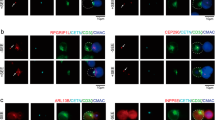Abstract
The focus of my laboratory is in three areas. The first area is our long-standing interest in the mechanics of T-cell activation. In addition to our interest in protein phosphorylation mediated by T-cell receptor engagement, we have been interested in defining the function of the immunologic synapse. The second area of focus is on the pathogenesis of glomerular disease. Here we are interested in the function of the podocyte and trying to understand how genetic deficiency of CD2AP in podocytes leads to kidney failure. The third area is the effect of modifiers of protein kinase cascades. Here we are focused on scaffold proteins, namely KSR and its role in controlling the activation of mitogen-activated protein kinase.
Similar content being viewed by others
References
Gauen LK, Zhu Y, Letourneur F, et al: Interactions of p59fyn and ZAP-70 with T-cell receptor activation motifs: defining the nature of a signalling motif. Mol Cell Biol 1994;14:3729–3741.
Shaw AS, Amrein KE, Hammond C, Stern DF, Sefton BM, Rose JK: The lck tyrosine protein kinase interacts with the cytoplasmic tail of the CD4 glycoprotein through its unique amino-terminal domain. Cell 1989;59:627–636.
Shaw AS, Chalupny J, Whitney JA, et al.: Short related sequences in the cytoplasmic domains of CD4 and CD8 mediate binding to the amino-terminal domain of the p56lck tyrosine protein kinase. Mol Cell Biol 1990; 10:1853–1862.
Timson Gauen LK, Kong AN, Samelson LE, Shaw AS: p59fyn tyrosine kinase associates with multiple T-cell receptor subunits through its unique amino-terminal domain. Mol Cell Biol 1992;12:5438–5446.
Timson Gauen LK, Linder ME, Shaw AS: Multiple features of the p59fyn src homology 4 domain define a motif for immune-receptor tyrosine-based activation motif (ITAM) binding and for plasma membrane localization. J Cell Biol 1996;133:1007–1015.
Shenoy-Scaria AM, Gauen LK, Kwong J, Shaw AS, Lublin DM: Palmitylation of an amino-terminal cysteine motif of protein tyrosine kinases p56lck and p59fyn mediates interaction with glycosyl-phosphatidylinositolanchored proteins. Mol Cell Biol 1993;13:6385–6392.
Bu JY, Shaw AS, Chan AC: Analysis of the interaction of ZAP-70 and syk protein-tyrosine kinases with the T-cell antigen receptor by plasmon resonance. Proc Natl Acad Sci USA 1995;92:5106–5110.
Shaw AS, Dustin ML: Making the T cell receptor go the distance: a topological view of T cell activation. Immunity 1997;6:361–369.
Dustin ML, Olszowy MW, Holdorf AD, et al: A novel adaptor protein orchestrates receptor patterning and cytoskeletal polarity in T-cell contacts. Cell 1998;94:667–677.
Grakoui A, Bromley SK, Sumen C, et al: The immunological synapse: a molecular machine controlling T cell activation. Science 1999;285:221–227.
Chakraborty AK, Dustin ML, Shaw AS: In silico models for cellular and molecular immunology: successes, promises and challenges. Nat Immunol 2003;4:933–936.
Lee KH, Dinner AR, Tu C, et al: The immunological synapse balances T cell receptor signaling and degradation. Science 2003;302:1218–1222.
Gout I, Middleton G, Adu J, et al: Negative regulation of PI 3-kinase by Ruk, a novel adaptor protein. EMBO J 2000;19:4015–4025.
Take H, Watanabe S, Takeda K, Yu ZX, Iwata N, Kajigaya S: Cloning and characterization of a novel adaptor protein, CIN85, that interacts with c-Cbl. Biochem Biophys Res Commun 2000;268:321–328.
Richard S, Yu D, Blumer KJ, et al: Association of p62, a multifunctional SH2- and SH3-domain-binding protein, with scr family tyrosine kinases, Grb2, and phsopholipids C gamma-1. Mol Cell Biol 1995;15:186–197.
Muslin AJ, Tanner JW, Allen PM, Shaw AS: Interaction of 14-3-3 with signaling proteins is mediated by the recognition of phosphoserine. Cell 1996;84:889–897.
Thorson JA, Yu LW, Hsu AL, et al: 14-3-3 proteins are required for maintenance of Raf-1 phosphorylation and kinase activity. Mol Cell Biol 1998;18:5229–5238.
Burack WR, Cheng AM, Shaw AS: Scaffolds, adaptors and linkers of TCR signaling: theory and practice. Curr Opin Immunol 2002;14:312–316.
Burack WR, Shaw AS: Signal transduction: hanging on a scaffold Curr Opin Cell Biol 2000;12:211–216.
Nguyen A, Burack WR, Stock JL, et al: Kinase suppressor of Ras (KSR) is a scaffold which facilitates mitogen-activated protein kinase activation in vivo. Mol Cell Biol 2002;22:3035–3045.
Kornfeld K, Hom DB, Horvitz HR: The ksr-1 gene encodes a novel protein kinase involved in Ras-mediated signaling in C. elegans. Cell 1995;83:903–913.
Therrien M, Chang HC, Solomon NM, Karim FD, Wassarman DA, Rubin GM: KSR, a novel protein kinase required for RAS signal transduction. Cell 1995;83:879–888.
Shih NY, Li J, Karpitskii V, et al: Congenital nephrotic syndrome in mice lacking CD2-associated protein. Science 1999;286:312–315.
Kim JM, Wu H, Green G, et al: CD-2 associated protein haploinsufficiency is linked to glomerular disease susceptibility. Science 2003;300:1298–1300.
Sallusto F, Cella M, Danieli C, Lanzavecchia A: Dendritic cells use macropinocytosis and the mannose receptor to concentrate macromolecules in the major histocompatibility complex class II compartment: down-regulation by cytokines and bacterial products. J Exp Med 1995;182:389–400.
Araki N, Hatae T, Yamada T, Hirohashi S: Actinin-4 is preferentially involved in circular ruffling and macropinocytosis in mouse macrophages: analysis by fluorescence ratio imaging. J Cell Sci 2000;113:3329–3340.
Author information
Authors and Affiliations
Corresponding author
Rights and permissions
About this article
Cite this article
Shaw, A.S. T-cell activation and immunologic synapse. Immunol Res 32, 247–252 (2005). https://doi.org/10.1385/IR:32:1-3:247
Issue Date:
DOI: https://doi.org/10.1385/IR:32:1-3:247




